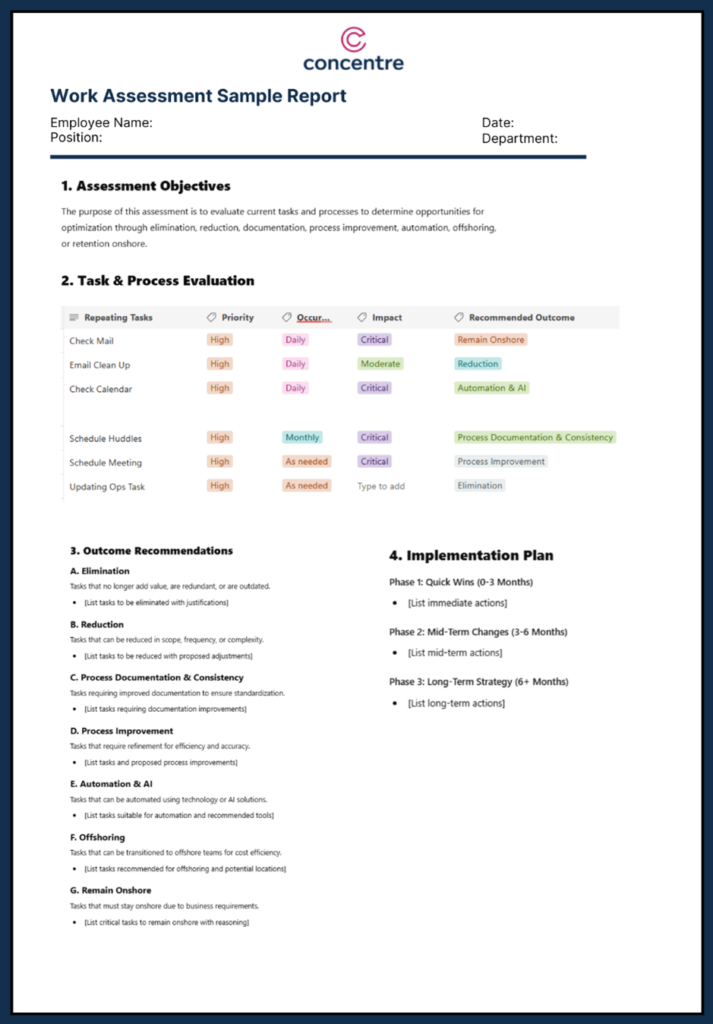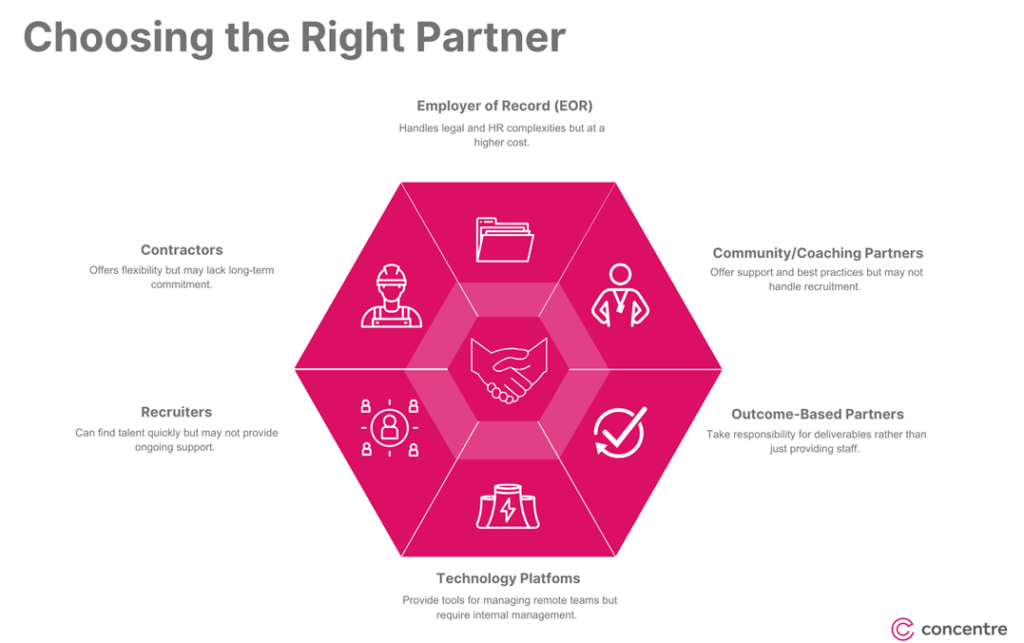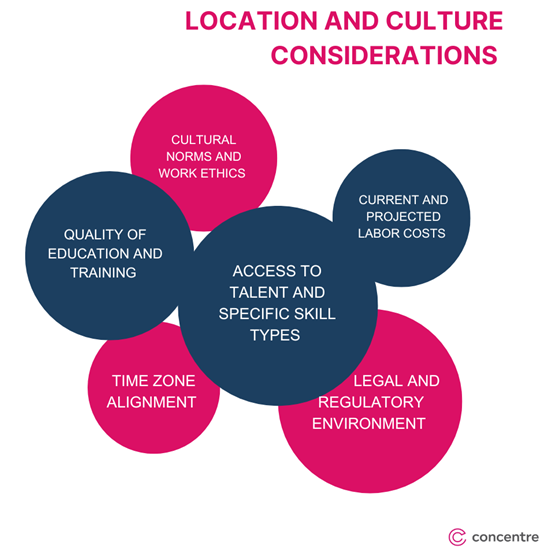As mid-market companies increasingly explore offshoring opportunities, it’s crucial to approach implementation with a well-thought-out strategy. The landscape has evolved, making it possible for even smaller companies to build remote offshore teams starting with three or four people, and accessing a wider range of skillsets than ever before.
As companies launch a plan to build a global team, there are a set of strategic questions that need to be answered before moving forward to implementation.
What Work Should Be Moved? Integrating with Automation and AI
An offshore strategy should be part of a comprehensive “work strategy.” Before deciding to offshore any task, or group of tasks, companies should first consider if it can be eliminated or reduced. That is—is the work that is being done delivering an outcome or product that is actually used by another team member, customer or supplier. If not, then that work needs to be eliminated.
Tools like Process & Work can help provide an objective view of where the opportunities exist within a company and the likely challenges involved in changing how that work is done.
This approach ensures that offshoring efforts focus on higher complexity tasks that truly require human skills and judgment. It also helps in clearly defining the roles and skillsets needed in the offshore team.
How Difficult Will It Be to Move The Work?
Several factors influence the ease and success of implementation:
- Work Repeatability: Companies with clear, repeatable (and consistently repeated) processes are often better suited for offshoring. This can be the case even without documented SOPs.
- Strength of Standard Operating Procedures (SOPs): Robust SOPs make it easier to train and integrate offshore team members.
- Data Quality: Good data management practices are crucial for effective collaboration and communication with offshore teams.
- Team Structure: A clear structure that supports how work moves through the organization. This is much easier than when a team has multiple functions or processes that it supports.
- Training: Complexity of the tasks to be moved, and the capacity of the team to deliver effective training.
It’s important to note that while companies nearing an exit can still benefit from offshoring, implementing a comprehensive offshore strategy often requires a multi-year approach for optimal results.

Time Zone Management: Challenge and Opportunity
One of the primary considerations in offshoring is managing work across different time zones. This is particularly crucial for time-sensitive tasks such as month-end closes or tax filings in accounting. However, what initially appears as a challenge can also be a significant advantage.
Companies can leverage the time difference to create a 24-hour work cycle, potentially improving customer service and operational efficiency. For instance, work started by an onshore team can be continued by an offshore team, ensuring faster turnaround times. The key is to strategically decide which tasks are best suited for synchronous (real-time) collaboration and which can be handled asynchronously and continuously
Build vs. Buy: A Critical Decision
One of the fundamental strategic decisions is whether to build an in-house offshore team or partner with an external provider. This decision often depends on factors such as the company’s time horizon (especially important for PE-backed companies considering an exit), the specific roles being recruited, and the planned team size.
Building an in-house team offers more control and can be more cost-effective in the long run but requires significant upfront investment in recruitment, training, and management. Partnering with an external provider can offer quicker setup and access to established processes but may come with less control and potentially higher costs over time.
Choosing the Right Partner
If the decision is to “buy”, companies have several options:
- Contractors: Offers flexibility but may lack long-term commitment.
- Employer of Record (EOR): Handles legal and HR complexities but at a higher cost.
- Recruiters: Can find talent quickly but may not provide ongoing support.
- Technology Platforms: Provide tools for managing remote teams but require internal management.
- Community/Coaching Partners: Offer support and best practices but may not handle recruitment.
- Outcome-Based Partners: Take responsibility for deliverables rather than just providing staff.

Each option has its pros and cons, and the choice depends on the company’s specific needs, resources, and long-term strategy.
Location and Culture Considerations
Choosing the right offshore location involves balancing several factors:
- Access to talent and specific skill types
- Quality of education and training
- Current and projected labor costs
- Cultural norms and work ethics
- Time zone alignment
- Legal and regulatory environment
It’s worth noting that some traditional offshoring destinations have seen significant cost increases. Companies need to look beyond just current costs and consider long-term trends and cultural fit.
Client Positioning and Pricing
Implementing an offshore strategy may impact how products and services are structured, packaged, or priced.
Companies need to decide whether offshore roles will be “unseen” from the client perspective or if they’ll be part of the value proposition.
For some businesses, offshoring can enable round the clock service or quicker turnaround times, which can be a selling point. For others, it might allow for more competitive pricing that enable market share gains. The key is to align the offshore strategy with the overall value proposition to clients.
Compliance and Regulatory Issues
Companies need to be aware of compliance issues in different countries, particularly regarding employee payments and tax responsibilities. Some countries have strict regulations about how employees must be paid and who is responsible for state and local taxes. Working with local experts or using an Employer of Record service can help navigate these complexities.
Communication Strategy
When implementing an offshore strategy, clear communication with existing team members is crucial. It’s important to outline the benefits for current employees, such as opportunities for skill development, leadership roles in managing offshore teams, or focusing on higher-value work. This is often easier in rapidly growing companies where offshoring supports expansion rather than replacement.
The pandemic has accelerated the adoption of remote work, making offshoring more acceptable to both employees and clients. It has also highlighted the importance of robust digital collaboration tools and processes, which are crucial for successful offshoring.
Implementing an offshore strategy requires careful consideration of multiple factors. By addressing these strategic issues thoughtfully, mid-market companies can leverage global talent to drive growth, increase efficiency, and enhance their competitive position. While the process may seem complex, the potential benefits in terms of scalability, access to diverse skills, and cost-effectiveness make it a valuable strategy for many growing businesses.




